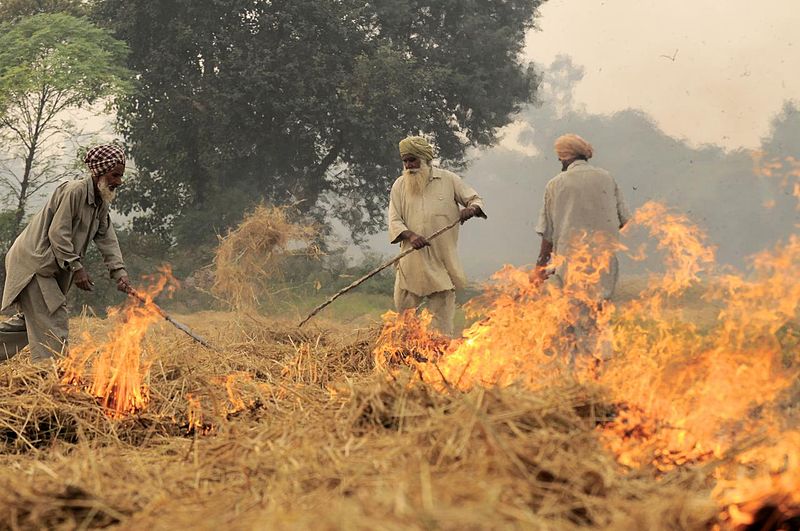It’s that time of the year when the infamous smog once again chokes the Delhi-National Capital Region (NCR), reigniting old debates on crop-burning and its alternatives. Year after year, almost every newspaper prints scathing columns condemning the smog that settles in the region due to the burning of crop residue. Why do farmers continue to burn crops?
Crop burning occurs during the short period between the harvest of Kharif season and the sowing of Rabi season. This leaves the farmers with around 15 days to harvest their crop and get the field ready for the sowing of seeds. Innovations implemented as a result of the Green Revolution changed agricultural practices. Technological innovations brought in the new mechanized style of harvesting which uses the combined harvester—primarily aimed for rice and wheat—to harvest crops. After running this harvester through the field, the short and stiff residue is leftover.
Upon harvesting the grains, the leftover stubble is cleared. This was cleared manually or by having cattle graze on the field in the earlier days. The leftover residue then provided fuel and fodder for cattle and was used as a source of compost for the fields. Now, as labour costs continue to increase, the work done manually takes more time. Thus, stubble burning, which is a cheap and accessible method of clearing fields for the next season, has become the norm. This has been a major reason for the smog.
But is the smog caused solely due to crop burning by farmers? While there is some truth to the statement made by these columns that condemn crop burning, it remains somewhat simplistic. Unfortunately, this season also happens to collide with Diwali. The already polluted Delhi air is overburdened with the added pressure of multiple field fires, adding insult to injury. But Diwali isn’t the only contributing factor for the decline in air quality.
As we get closer to winter, the temperature around this time is just starting to drop. We know that hot air, now filled with pollutants, rises. However, as elevation increases, the atmospheric temperature begins to drop due to the thinner atmosphere. At this point, where the temperature starts dropping in the atmosphere, the pollutants remain trapped, creating a shield that prevents the polluted air from rising any further. This causes the pollutants to remain in the air that we breathe, creating smog. The lack of strong winds in the region during this time of the year is also a significant contributing factor and results in the pollutants being suspended in the air.
One can interpret the smog to be the result of the intersection of various unfavourable factors including geography, climatic conditions, industrial and capitalist processes, technology, illiteracy, need, desperation and perhaps, the lack of adequate alternatives.
As a solution, governments have gone from levying heavy taxes on farmers and passing an ordinance for a 20-member committee to tackle air pollution in the NCR. However, stringent laws and harsh punishments rarely, if ever, act as preventive measures. In our present situation, creating committees is simply a redundant act of pushing the burden of accountability on a different set of shoulders.
The recurring smog is battled with feeble water spray machines, air purifiers and masks. In reality, these are all but preventive, and we may have misunderstood the problem at its root for a significantly long time. The introduction of specialized agricultural machines, subsidies and loans along with strict laws are but mitigating factors. None of which consider the long-term health of agriculturists, consumers, soil health, accessibility and soil toxicity—all which are significant and yet not spoken about. To battle pollution arising out of crop residue burning, we must first arrive at a clear understanding of the problem. Dedicated research, trials and increase in government support in agriculture are key to arriving at a robust solution for this problem.
Given these “solutions”, our future seems but a foggier rendition of the present and the past. Policies aimed at diversification of crops grown will help us take a step towards a long-term solution to the adverse effect of the pollution arising from crop burning. However, battling smog does not end here, industrial pollutants demand a more complex approach which is beyond the scope of this article.
A possible solution could be to replace monocultures in favour of polycultures. Diversification of the regions where these crops are grown could also help. Creating policies favouring state-sponsored labour, or perhaps changing the kind of seeds we use.
Various complexities drive the problem of pollution in India. One may trace the roots back to the green revolution, maybe even condemn it. But the truth of the matter is that we must rethink the industrial model of agriculture that is rampantly in practice today. We must rethink agriculture.
Hiteshi Ajmera is a student of Political Science and Environmental Studies at Ashoka University.
Image Credit: Photograph by Neil Palmer, distributed under CC BY-SA 2.0
We publish all articles under a Creative Commons Attribution-Noderivatives license. This means any news organisation, blog, website, newspaper or newsletter can republish our pieces for free, provided they attribute the original source (OpenAxis).


One reply on “The Infamous Smog: Crop burning and much more”
Excellent analysis and also good solution towards solving the problem of smog .
LikeLiked by 1 person